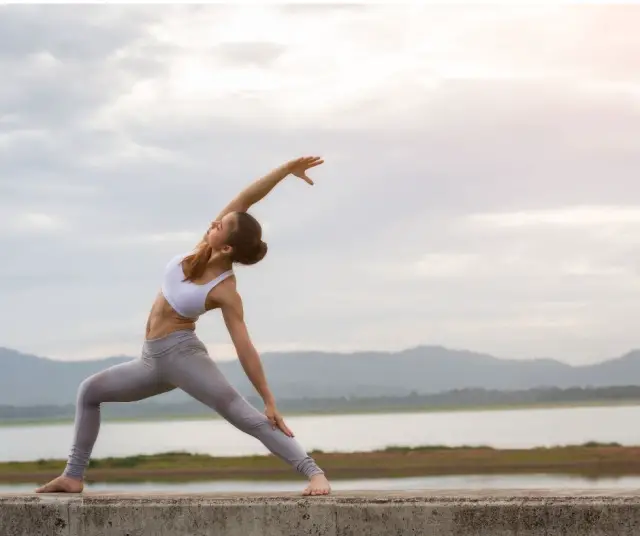Yoga is an ancient practice that has captured the attention of millions of people around the world. Originating in India more than 5,000 years ago, yoga combines physical, breathing and meditative exercises to promote physical, mental and spiritual well-being.
What is Yoga?
The term "yoga" comes from Sanskrit and means "union" or "integration." The practice of yoga seeks the union of body, mind and spirit, and is based on philosophical principles that include ethics, personal discipline and spiritual development.
Yoga is made up of several branches, each with its specific focus:
Hatha Yoga: Focuses on the practice of physical postures (asanas) and breathing exercises (pranayama).
Raja Yoga: Known as royal yoga, it focuses on meditation and mind control.
Karma Yoga: The yoga of selfless action is based on performing good actions without expecting anything in return.
Bhakti Yoga: The yoga of devotion involves surrender to a deity or divine principle.
Jnana Yoga: The yoga of knowledge and wisdom, focused on study and introspection.
Tantra Yoga: Involves rituals and practices that seek the expansion of consciousness.
Benefits of Yoga
Regular yoga practice offers a wide range of physical, mental and emotional health benefits. Some of the most notable benefits include:
Physical Benefits
Improved Flexibility: Yoga poses stretch and tone muscles, increasing the overall flexibility of the body.
Muscle Strengthening: Many asanas require strength, which helps tone and strengthen muscles.
Improved Posture: Regular practice helps align the spine and improve posture, which can prevent back and neck pain.
Increased Energy: Yoga can revitalize the body and increase energy levels.
Cardiovascular Health: Some styles of yoga, such as Vinyasa and Ashtanga, can improve blood circulation and heart health.
Mental and Emotional Benefits
Stress Reduction: Yoga promotes relaxation and reduces stress through breathing and meditation techniques.
Improved Concentration: Regular practice can improve your ability to concentrate and mental clarity.
Emotional Balance: Yoga helps manage emotions and develop a more positive attitude towards life.
Quality Sleep: Deep relaxation induced by yoga can improve the quality of sleep.
Self-awareness: The practice of yoga encourages introspection and self-knowledge, which can lead to a greater sense of purpose and personal satisfaction.
Different Yoga Styles
There are numerous styles of yoga, each with its specific focus and benefits. Here are some of the most popular styles:
Hatha Yoga
It is one of the most practiced styles in the West and focuses on postures (asanas) and breathing techniques (pranayama). It is ideal for beginners, as it is practiced at a slow and controlled pace.
Vinyasa Yoga
Also known as flow yoga, Vinyasa connects breathing with movement in a fluid sequence of postures. It is a dynamic and vigorous style that can be challenging for beginners.
Ashtanga Yoga
This is a more rigorous and structured style of yoga that follows a specific sequence of postures. It is physically demanding and is ideal for those looking for an intensive workout.
Bikram Yoga
It is practiced in a room heated to 40 degrees Celsius with 40% humidity. It consists of a series of 26 postures and two breathing exercises. It is excellent for detoxification and improving flexibility.
Kundalini Yoga
This style focuses on activating the kundalini energy found at the base of the spine. It combines physical postures, breathing, singing and meditation.
Iyengar Yoga
Focused on precision and alignment, this style uses props such as blocks, belts, and blankets to help practitioners perform the poses correctly.
Yin Yoga
It is a passive style that focuses on holding postures for long periods of time, deeply stretching connective tissues and promoting deep relaxation.
How to Start your Yoga Practice
If you are interested in getting started with yoga, here are some tips to get you started:
Find a Good Instructor
Finding a good yoga instructor is crucial, especially if you are a beginner. A qualified instructor can teach you the correct form of the postures and help you avoid injury.
Get the Necessary Equipment
Although you don't need much equipment to practice yoga, a good non-slip mat is essential. You may also need blocks, a strap, and a blanket, depending on the style of yoga you practice.
Establish a Practice Space
Find a quiet place free of distractions where you can practice yoga. A clean and tidy space can help you concentrate better.
Start with Beginner Classes
If you are new to yoga, it is advisable to start with beginner classes. This will allow you to learn the basic postures and become familiar with the fundamental concepts.
Listen to your Body
It is important to listen to your body and not push yourself beyond your limits. Yoga is not about competition, but about developing a healthy and conscious connection with your body.
Practice Regularly
Consistency is key in yoga. Try to practice at least two to three times a week to get maximum benefits.
Yoga is a multifaceted practice that offers numerous benefits for the body, mind and spirit. With a wide variety of styles and approaches, there is something for everyone in yoga. Whether you are looking to improve your flexibility, reduce stress, strengthen your body, or simply find a moment of peace in your day, yoga can be a powerful tool to improve your quality of life. Start your yoga journey today and discover everything this ancient practice has to offer you.
